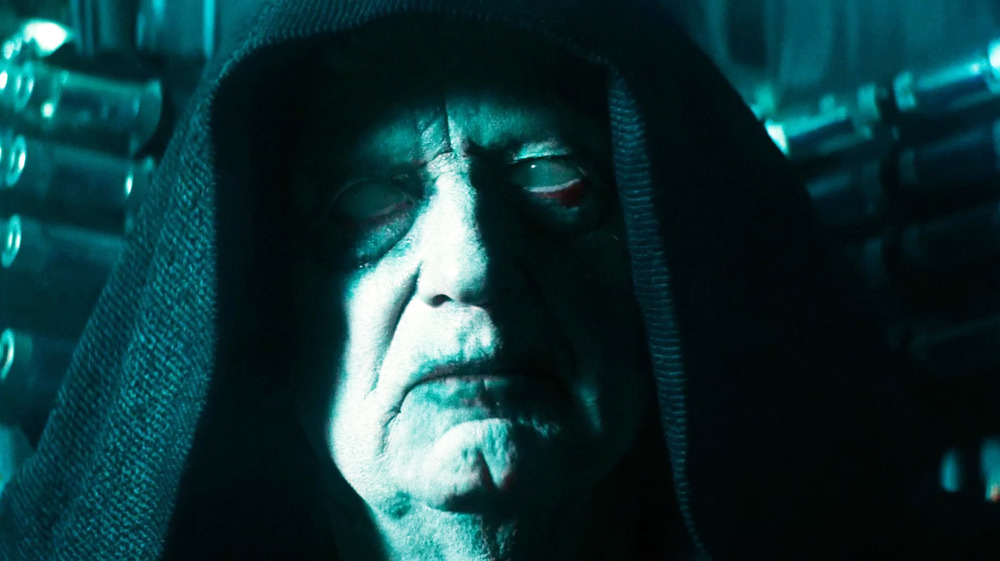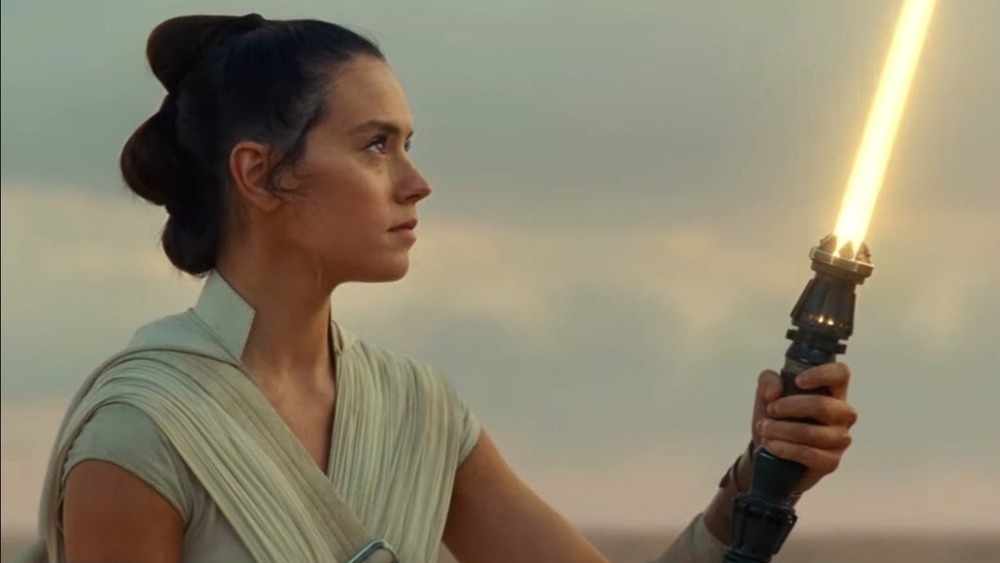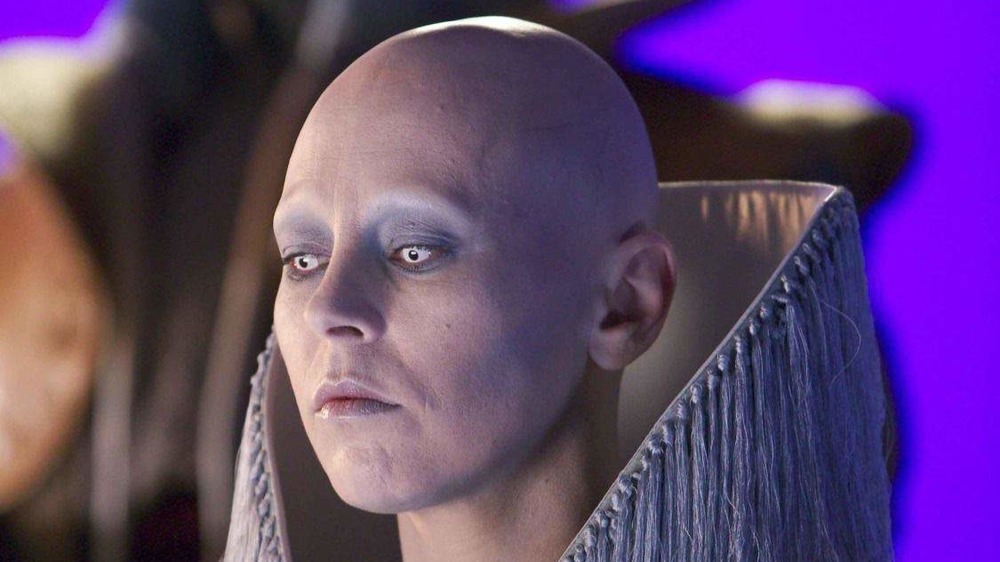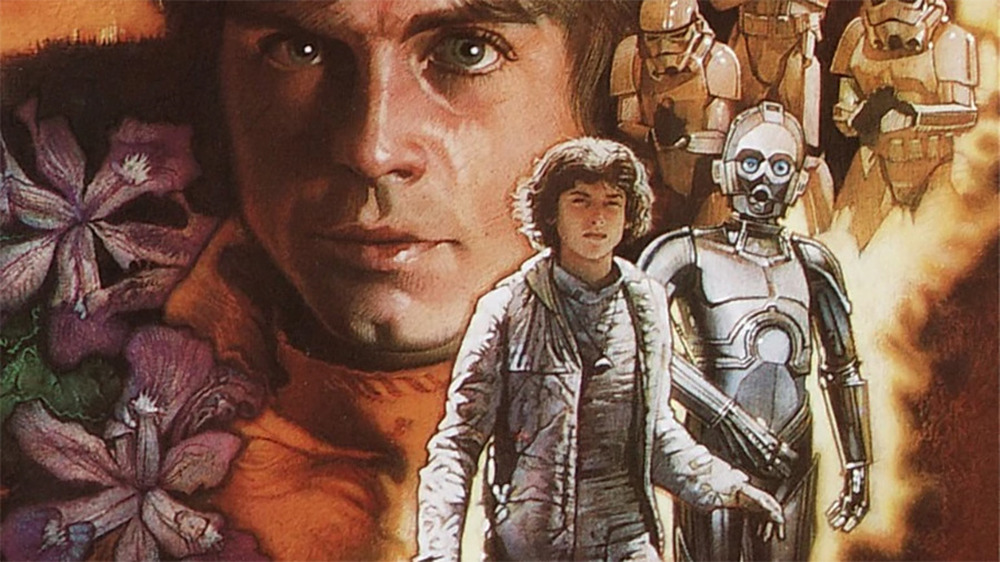Who Was Palpatine's Son In Star Wars?
Is there something about everyone's favorite galaxy far, far away that you just can't figure out? Looper's resident Star Wars expert is here to help. If you want to ask a question, send it to @Looper on Twitter with the hashtag #AskTheStarWarsExpert, or email it to staff@looper.com with the subject like "Ask the Star Wars Expert." We'll see what we can do.
Q: If Rey is Palpatine's granddaughter, who are her parents? — via email
Star Wars: Episode IX — The Rise of Skywalker dropped a major bombshell on the Star Wars universe: Emperor Palpatine had a family. Not only is Rey "Nobody" actually Palpatine's granddaughter, but shortly after she was born, the man also known as Darth Sidious had her father killed by a Sith assassin named Ochi.
Whether you like that twist or not — and boy, are fans divided — you can't deny that it raises some big questions about the Palpatine family tree. Was there really a woman out there willing to bump uglies with the despotic, monkey-eyed Emperor? When, exactly, was the Emperor's mysterious son born, and how did Palpatine make him such a well-kept secret? And, if she's not part of the Palpatine line, who exactly was Rey's mother?
Not all of these questions have answers. While Rey's mom is played by no less than Killing Eve's Jodie Comer, her The Rise of Skywalker appearance is little more than a glorified cameo. We don't know anything about her, at least for now. However, The Rise of Skywalker's media tie-ins do reveal a little bit more about Palpatine's son — and reveal, somewhat surprisingly, that he's directly tied to Palpatine's mysterious resurrection.
Send in the Clones. Yes, again
The Rise of Skywalker doesn't explicitly say how Palpatine escaped death, although it does drop a couple of hints. When Kylo visits Exegol for the first time, he finds Supreme Leader Snoke clones floating in tubes. Later, Dominic Monaghan's character, Beaumont Kin, offers a handful of theories of his own: "Dark science. Cloning. Secrets only the Sith knew."
As it turns out, Beaumont nailed it — Palpatine's return relies on all three. Like the Star Wars movie novelizations, Rae Carson's The Rise of Skywalker: Expanded Edition fleshes out the story that we saw on the big screen. That includes Palpatine's return. Basically? He used clones. While ruling the galaxy, Palpatine set up a secret cloning lab on the planet Exegol. As he fell down the second Death Star's reactor shaft in Return of the Jedi, Palpatine used the Force to project his consciousness into a new body on the far-off Sith stronghold, a skill that Carson implies he learned from his former master, Darth Plagueis.
Unfortunately, things didn't go exactly as Palpatine had planned. "The secret place had not completed its preparations," Carson writes. "The transfer was imperfect, and the cloned body wasn't enough." Apparently, the dark side takes a big physical toll, and Palpatine's new vessel burned out quickly. And so, as the New Republic took control of the galaxy and the First Order accumulated power in the Unknown Regions, Palpatine's Sith followers worked tirelessly to create the Emperor a new, healthier, and more permanent body.
Most of those experiments failed. One didn't. At least, not exactly. "One genetic strandcast lived," Carson writes. "Thrived, even. A not-quite-identical clone. His 'son.'" Still, even that body wasn't perfect. While the clone survived the Sith experiments, he couldn't use the Force. That weakness disgusted Palpatine. Instead of using the clone as a host, the former Emperor found another use for him. He set his "son" free, so it could "continu[e] the bloodline through more natural methods."
That worked. Palpatine's son met a lady and had a daughter — that's Rey — whose powers met Palpatine's standards. And so, the Sith lord began making plans to capture Rey and take over her body. As we've seen, that didn't exactly pan out.
But how canon is this?
Carson's explanation dodges a lot of the more difficult questions about Palpatine's family tree — no, as it turns out, there isn't a Mrs. Palpatine out there — and while it means that Rey's father isn't technically Palpatine's son (they just share a lot of the same DNA), it does meet Star Wars precedent. Back in the prequel era, for example, Jango Fett treated his young clone, Boba, like a son. This is pretty much the same thing.
At least, it is for now. The Star Wars movie novelizations occupy a liminal space in Star Wars continuity, and it's possible future projects will retcon Carson's work. While Disney claims that all Star Wars material created after 2014, in addition to the first six Star Wars movies and The Clone Wars animated series, are in-canon, that's not strictly true. Movie novelizations only seem to "count" until they're contradicted by other, higher-profile material. For example, there's a scene in Alan Dean Foster's novelization of The Force Awakens in which Rey and Poe meet for the first time (in the movie, they never speak to one another). That's no longer canon — it's been superseded by a similar moment at the end of The Last Jedi.
As such, it's possible that Carson's explanation for Rey's ancestry won't survive long-term. After all, it's happened before. In the years before Disney bought Star Wars, the Emperor had a completely different son. However, when the Mouse House took over, it wiped away most of Star Wars' established continuity. Palpatine's first kid disappeared with it.
Tell me Moore
As documented in Paul and Hollace David's "Jedi Prince" saga, the Emperor's original son was Triclops, a three-eyed human with considerable Force powers. However, to understand his origins, you actually have to go back to the prequel timeline, where you'll find a woman named Sly Moore. A Force-sensitive native of the planet Umbara, Moore was one of Palpatine's most trusted advisors. Not only was she one of the few people privy to Palpatine's alter ego Darth Sidious and his plan to overthrow the Republic, but rumors suggest that they were lovers, too.
Moore gave birth to Triclops after impregnating herself with "Force-sensitive DNA" she procured from an anonymous source, which is largely implied to be Palpatine. That makes Triclops Palpatine's biological son. However, Moore is also responsible for creating Triclops' biggest rival. While conducting bioengineering experiments, Sly created a different three-eyed mutant named Trioculus, who tried to take control of the Empire after Palpatine's death.
See, an ancient legend perpetuated by a cult called Prophets of the Dark Side foretold the coming of a three-eyed savior with incredible Force abilities. In reality, this prophecy referred to Triclops, but Trioculus and the Prophets used it as an excuse to grab power, falsely claiming that Trioculus was Palpatine's heir (he even had machines attached to his wrists that mimicked the effects of Force lightning). It might've worked, too, if the dark side cultists hadn't fallen prey to infighting, or if Trioculus hadn't fallen in love with Princess Leia, tried to kidnap her, and then gotten killed by her robot double.
Seeing triple
There's pretty much no chance that J. J. Abrams and his Rise of Skywalker co-writer, Chris Terrio, looked at Triclops' story while writing Episode IX. Outside of the Davids' six "Jedi Prince" novels, which are aimed squarely at children, he doesn't make much of an impact on the old Expanded Universe.
Still, there are some striking similarities between Triclops and Rey's unnamed father. For one, neither of them got along with their dad. After Triclops was born, Palpatine banished him to the spice mines in Kessel, fearing his power and his pacifist philosophy. In addition, both had children. While imprisoned, Triclops fell in love with a former Jedi named Kendalina. Shortly afterwards, Kendalina gave birth to a son named Ken, who was later whisked away to a secret Jedi city on Yavin IV by an unknown savior.
Like Rey, Ken — the titular "Jedi prince" of the Davids' saga — was an incredibly powerful Force user. Like Rey, he was devastated when he learned that he was Palpatine's grandson (ironically, he had hoped he was related to Obi-Wan Kenobi, echoing one of the most popular fan theories about Rey's heritage). Finally, like Rey, Ken ended up rejecting his birthright, joining the New Republic, and training under Luke Skywalker. So while both Ken and Triclops are little more than footnotes in Star Wars' big, sprawling history, you can see how their legacy lives on in The Rise of Skywalker — at least from a certain point of view.




